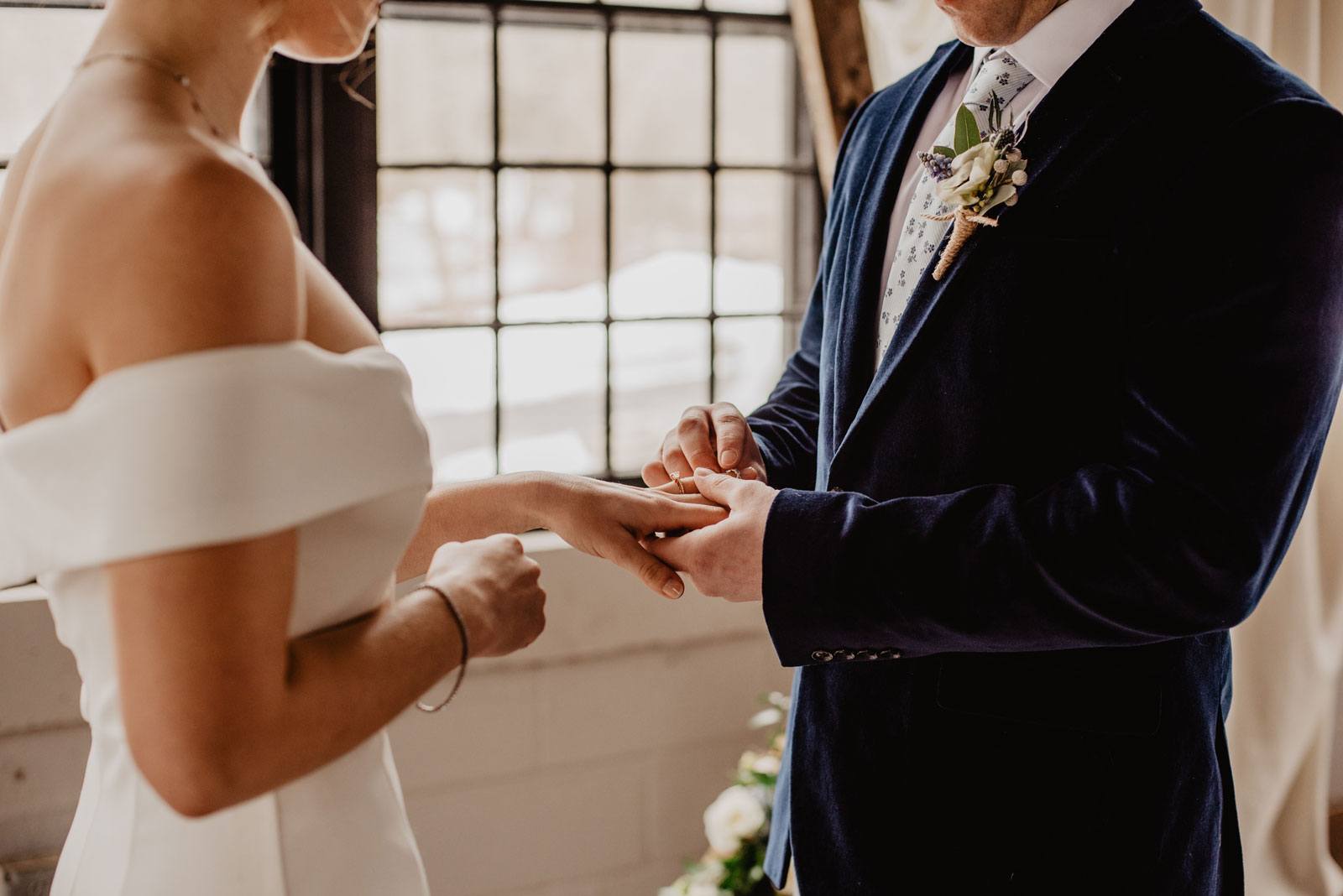Which Finger Does a Wedding Ring Go on?
The wedding ring exchange is one of our favorite moments at each wedding. It is a moment that speaks of your commitment to each other and we love the almost magical aura surrounding it.
Naturally, we love filming it, and our wedding films typically include the wedding ring exchange. When we edit the shots from a wedding, the ring exchange stands out as a moment for its significance and the promises it holds. Couples love to see their fingers interlaced in a close-up film shot. This moment captures the essence of their wedding and turns their love from concept to reality.
While wedding traditions have evolved through time, the wedding ring custom is a ritual that remains pretty much unchanged. Most couples in the United States choose to place a gold wedding ring on the fourth finger of their left hand.
Some couples choose another finger or the right hand for their wedding ring and that is absolutely fine. If anything, traditions and cultural customs can be changed, as long as the couple speaks of love and commitment. However, there is something to be said about the traditional wedding finger and the millennia-long history behind it.
How Long Have We Been Exchanging Wedding Rings?
Ancient Egyptians used to exchange wedding rings before 4,000 BC—over 6,000 years ago. We have found in Ancient Egypt testimonies of couples exchanging reed and bone rings and making pledges of eternal love.
Interestingly enough, the wedding ring was not worn exclusively on a particular finger. There have been mentions of wearing them on the thumb—or any other finger, for that matter.
The tradition is also found in ancient Greece and throughout the Roman Empire. Couples usually exchanged wedding rings made of iron, ivory, bone, silver, and gold. Sometimes, other materials were used, including leather and most other metals.
The Love Vein
The Romans had three kinds of marriage. Usus was common-law cohabitation. Coemptio was a commercial marriage arranged by male relatives. Confarreatio was legal marriage among nobles. Only in the latter did the groom give his bride a ring, called annulus pronubus—the bride’s ring. This ring was made of iron to symbolize the strength and unbreakable nature of marriage and the permanence of this bond. Iron being precious, the ring also symbolized the groom’s ability to provide for his new bride.
The opening in the middle of the ring symbolized a portal to the couple’s love but also to married life. Once you go through this gateway, you are no longer a daughter but a wife and a future mother, with all the pleasures and challenges family life entails.
The annulus pronubus was typically worn on the fourth finger of the left hand. Romans had a particularly romantic view of the human body, believing that this finger was directly connected to the heart. In a Roman’s mind, it therefore makes perfect sense to place the wedding ring on that finger, to symbolize the couple’s love and directly link the ring to the wearer’s heart.
Alas, modern medical science has disproved this myth: all veins lead to the heart. Even so, this ancient custom has remained intact. The vena amoris, or vein of love, as the Romans used to call this particular vein, is a beautiful tradition that couples hold dear to this day.

What Is the Ring Made of?
Gold has long been the metal of choice when it comes to wedding rings. Even during the Second World War, when gold was limited, couples getting married were able to purchase so-called utility rings. They may have only weighed 3 grams and had just 9 carats, but they were still gold.
Today, when people opt for gold, they can choose yellow gold as a symbol of fidelity, white gold for friendship, or rose gold for romantic love. Some combine the three into a tri-metal band to symbolize all three, as well as your shared past, present, and future.
While gold is usually preferred for the ring, this is hardly the only option. Some people wear rings made of bamboo for environmental reasons, thus returning to the ancient Egyptian custom. Others prefer a tattoo or even a ring made of silicone—a common choice among health workers and people with heavily hands-on daily routines such as assembly line workers, who worry about the possibility of the wedding ring catching on a machine.
The Wedding Ring Today
Rings traditionally symbolize devotion, fidelity, and eternity. The circle is a universal symbol of infinity.
Your wedding ring is a visual commitment to your partner. It is a symbol of love, determination, and responsibility toward each other. It is also a social symbol that signals you are in a committed relationship with another.
Like the Romans, most couples choose to put on the fourth finger of the left hand, especially in the US. In some countries, however, you would wear the engagement ring on the left hand and the wedding one on the right. Tradition in India, for example, stipulates that the left hand is improper and impure, so couples place their wedding rings on the right hand. Wearing the wedding ring on the right hand is still going strong in countries like Germany, Norway, Greece, Austria, and Denmark.
Whatever your choice, remember that nothing is compulsory! Your wedding should be exactly how you envisioned it. It depends only on how you perceive your love. If you want to wear your wedding ring on your thumb, you have every right to do so. If you don’t want a gold ring, that’s fine, too.
As wedding filmographers and videographers, we are always in awe every time a couple exchanges vows and wedding rings. Seen from behind the camera, it is a powerful moment of true love and dedication. The ring, wherever it is placed, is there to remind the couple to be brave and persistent to protect their relationship. Such a powerful moment makes for astonishing video takes.
Reverent Wedding Films can film weddings in Waco, Bryan, Longview, Woodlands, San Antonio, Houston, Dallas/Fort Worth, Austin, New Braunfels, and San Antonio, Texas, as well as destination weddings all over the world. Check our availability online or call now 832-536-1897 for a cinematic wedding film that captures all of a wedding’s moving moments!








 The season of love stories to
The season of love stories to

Vendor
Vendor










One Comment